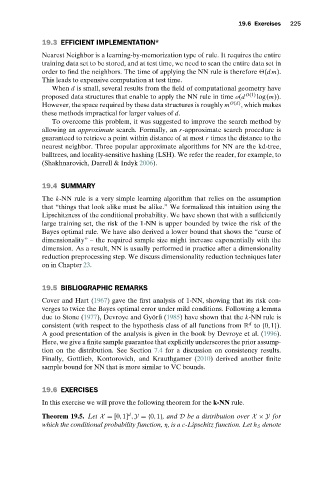Page 243 - Understanding Machine Learning
P. 243
19.6 Exercises 225
19.3 EFFICIENT IMPLEMENTATION*
Nearest Neighbor is a learning-by-memorization type of rule. It requires the entire
training data set to be stored, and at test time, we need to scan the entire data set in
order to find the neighbors. The time of applying the NN rule is therefore (dm).
This leads to expensive computation at test time.
When d is small, several results from the field of computational geometry have
proposed data structures that enable to apply the NN rule in time o(d O(1) log(m)).
However, the space required by these data structures is roughly m O(d) , which makes
these methods impractical for larger values of d.
To overcome this problem, it was suggested to improve the search method by
allowing an approximate search. Formally, an r-approximate search procedure is
guaranteed to retrieve a point within distance of at most r times the distance to the
nearest neighbor. Three popular approximate algorithms for NN are the kd-tree,
balltrees, and locality-sensitive hashing (LSH). We refer the reader, for example, to
(Shakhnarovich, Darrell & Indyk 2006).
19.4 SUMMARY
The k-NN rule is a very simple learning algorithm that relies on the assumption
that “things that look alike must be alike.” We formalized this intuition using the
Lipschitzness of the conditional probability. We have shown that with a sufficiently
large training set, the risk of the 1-NN is upper bounded by twice the risk of the
Bayes optimal rule. We have also derived a lower bound that shows the “curse of
dimensionality” – the required sample size might increase exponentially with the
dimension. As a result, NN is usually performed in practice after a dimensionality
reduction preprocessing step. We discuss dimensionality reduction techniques later
on in Chapter 23.
19.5 BIBLIOGRAPHIC REMARKS
Cover and Hart (1967) gave the first analysis of 1-NN, showing that its risk con-
verges to twice the Bayes optimal error under mild conditions. Following a lemma
due to Stone (1977), Devroye and Györfi (1985) have shown that the k-NN rule is
d
consistent (with respect to the hypothesis class of all functions from R to {0,1}).
A good presentation of the analysis is given in the book by Devroye et al. (1996).
Here, we give a finite sample guarantee that explicitly underscores the prior assump-
tion on the distribution. See Section 7.4 for a discussion on consistency results.
Finally, Gottlieb, Kontorovich, and Krauthgamer (2010) derived another finite
sample bound for NN that is more similar to VC bounds.
19.6 EXERCISES
In this exercise we will prove the following theorem for the k-NN rule.
d
Theorem 19.5. Let X = [0,1] ,Y ={0,1},and D be a distribution over X × Y for
which the conditional probability function, η,is a c-Lipschitz function. Let h S denote

